Auditing and Professional Practice: Account Analysis and Procedures
VerifiedAdded on 2020/05/16
|11
|1872
|338
Homework Assignment
AI Summary
This assignment focuses on auditing and professional practice, providing a detailed analysis of audit planning and procedures. The student has selected and analyzed five key accounts: cost of sales, other income, inventory, cash, and superannuation. For each account, the student provides a rationale for selection, outlines the relevant assertions, and recommends specific audit procedures. The analysis includes a discussion of analytical review, materiality, and the importance of proper accounting practices. The student emphasizes the need to investigate unusual fluctuations and potential misstatements within the financial statements. The assignment provides a comprehensive overview of the audit process, from initial planning to the examination of specific account balances, highlighting the importance of ensuring the accuracy and reliability of financial information. The document includes references to relevant literature to support the analysis.
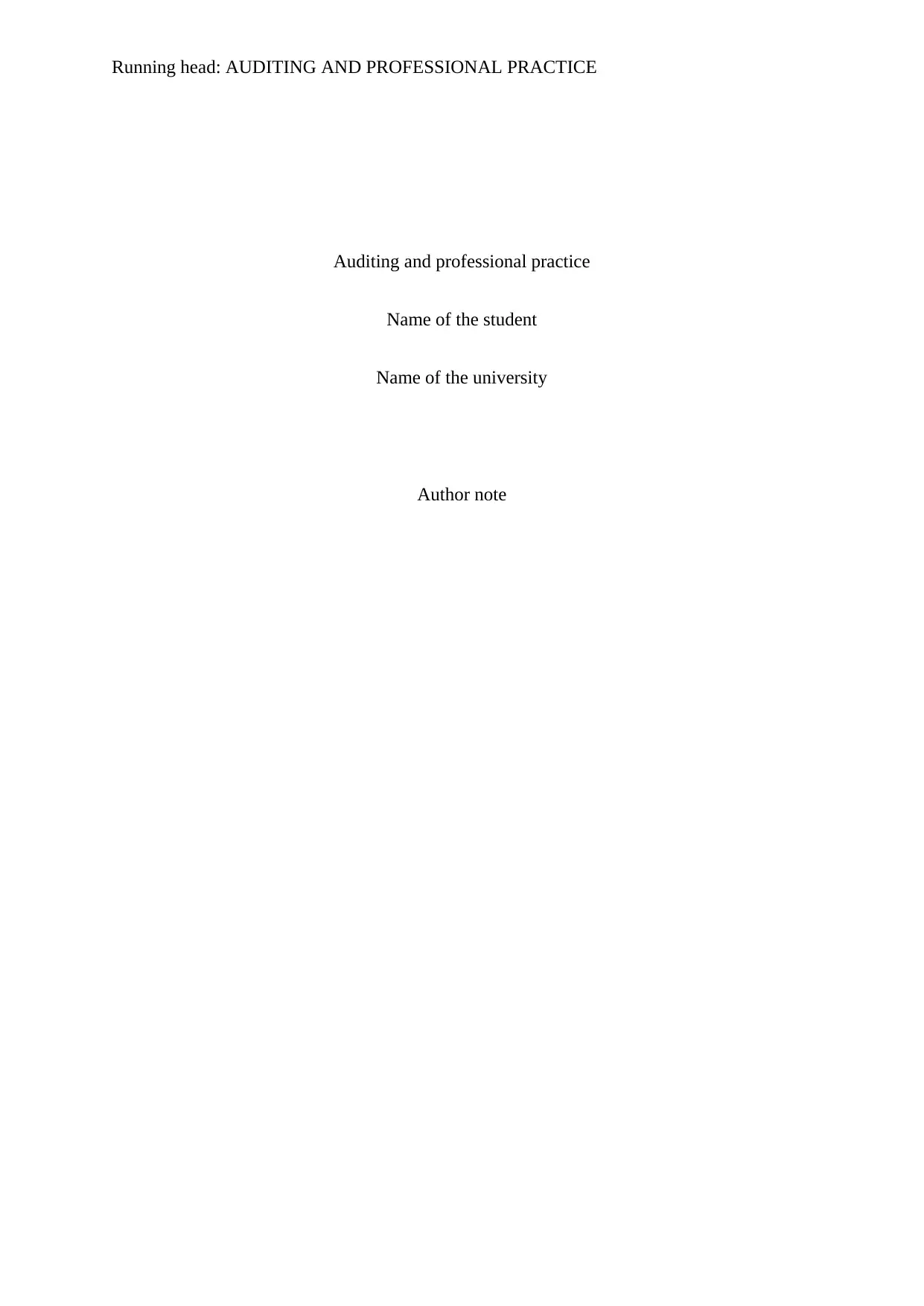
Running head: AUDITING AND PROFESSIONAL PRACTICE
Auditing and professional practice
Name of the student
Name of the university
Author note
Auditing and professional practice
Name of the student
Name of the university
Author note
Paraphrase This Document
Need a fresh take? Get an instant paraphrase of this document with our AI Paraphraser
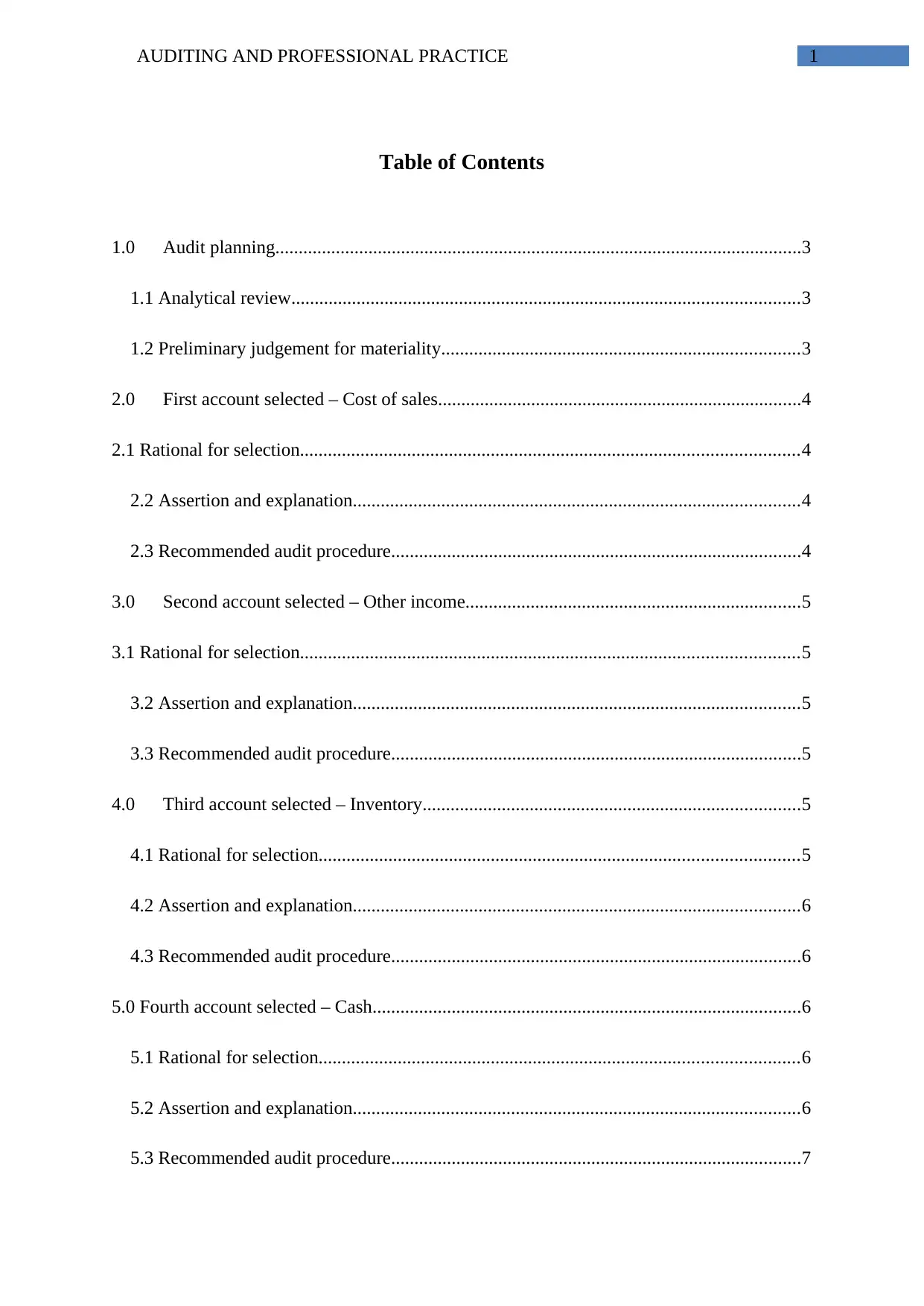
1AUDITING AND PROFESSIONAL PRACTICE
Table of Contents
1.0 Audit planning.................................................................................................................3
1.1 Analytical review.............................................................................................................3
1.2 Preliminary judgement for materiality.............................................................................3
2.0 First account selected – Cost of sales..............................................................................4
2.1 Rational for selection...........................................................................................................4
2.2 Assertion and explanation................................................................................................4
2.3 Recommended audit procedure........................................................................................4
3.0 Second account selected – Other income........................................................................5
3.1 Rational for selection...........................................................................................................5
3.2 Assertion and explanation................................................................................................5
3.3 Recommended audit procedure........................................................................................5
4.0 Third account selected – Inventory.................................................................................5
4.1 Rational for selection.......................................................................................................5
4.2 Assertion and explanation................................................................................................6
4.3 Recommended audit procedure........................................................................................6
5.0 Fourth account selected – Cash............................................................................................6
5.1 Rational for selection.......................................................................................................6
5.2 Assertion and explanation................................................................................................6
5.3 Recommended audit procedure........................................................................................7
Table of Contents
1.0 Audit planning.................................................................................................................3
1.1 Analytical review.............................................................................................................3
1.2 Preliminary judgement for materiality.............................................................................3
2.0 First account selected – Cost of sales..............................................................................4
2.1 Rational for selection...........................................................................................................4
2.2 Assertion and explanation................................................................................................4
2.3 Recommended audit procedure........................................................................................4
3.0 Second account selected – Other income........................................................................5
3.1 Rational for selection...........................................................................................................5
3.2 Assertion and explanation................................................................................................5
3.3 Recommended audit procedure........................................................................................5
4.0 Third account selected – Inventory.................................................................................5
4.1 Rational for selection.......................................................................................................5
4.2 Assertion and explanation................................................................................................6
4.3 Recommended audit procedure........................................................................................6
5.0 Fourth account selected – Cash............................................................................................6
5.1 Rational for selection.......................................................................................................6
5.2 Assertion and explanation................................................................................................6
5.3 Recommended audit procedure........................................................................................7
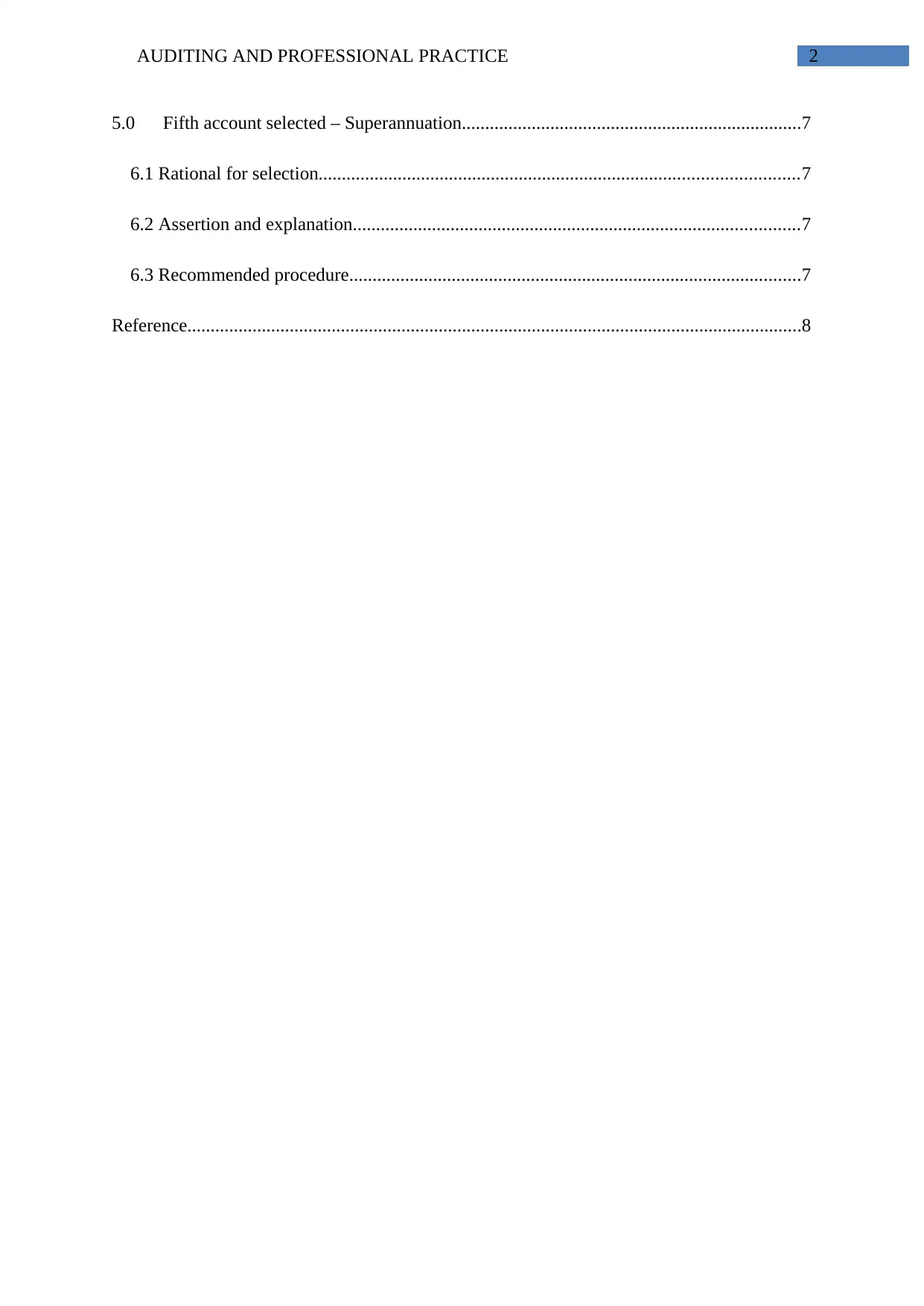
2AUDITING AND PROFESSIONAL PRACTICE
5.0 Fifth account selected – Superannuation.........................................................................7
6.1 Rational for selection.......................................................................................................7
6.2 Assertion and explanation................................................................................................7
6.3 Recommended procedure.................................................................................................7
Reference....................................................................................................................................8
5.0 Fifth account selected – Superannuation.........................................................................7
6.1 Rational for selection.......................................................................................................7
6.2 Assertion and explanation................................................................................................7
6.3 Recommended procedure.................................................................................................7
Reference....................................................................................................................................8
⊘ This is a preview!⊘
Do you want full access?
Subscribe today to unlock all pages.

Trusted by 1+ million students worldwide
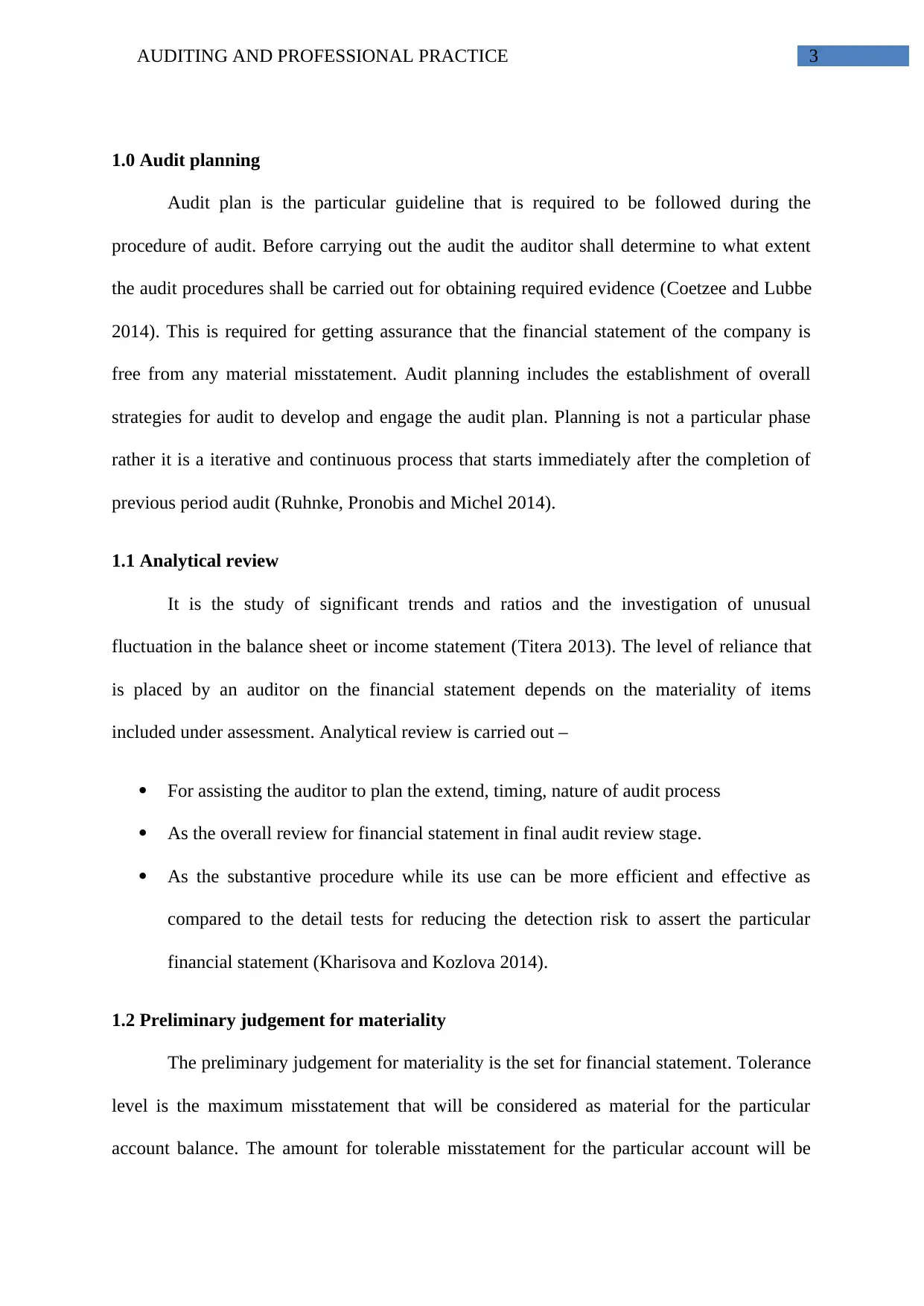
3AUDITING AND PROFESSIONAL PRACTICE
1.0 Audit planning
Audit plan is the particular guideline that is required to be followed during the
procedure of audit. Before carrying out the audit the auditor shall determine to what extent
the audit procedures shall be carried out for obtaining required evidence (Coetzee and Lubbe
2014). This is required for getting assurance that the financial statement of the company is
free from any material misstatement. Audit planning includes the establishment of overall
strategies for audit to develop and engage the audit plan. Planning is not a particular phase
rather it is a iterative and continuous process that starts immediately after the completion of
previous period audit (Ruhnke, Pronobis and Michel 2014).
1.1 Analytical review
It is the study of significant trends and ratios and the investigation of unusual
fluctuation in the balance sheet or income statement (Titera 2013). The level of reliance that
is placed by an auditor on the financial statement depends on the materiality of items
included under assessment. Analytical review is carried out –
For assisting the auditor to plan the extend, timing, nature of audit process
As the overall review for financial statement in final audit review stage.
As the substantive procedure while its use can be more efficient and effective as
compared to the detail tests for reducing the detection risk to assert the particular
financial statement (Kharisova and Kozlova 2014).
1.2 Preliminary judgement for materiality
The preliminary judgement for materiality is the set for financial statement. Tolerance
level is the maximum misstatement that will be considered as material for the particular
account balance. The amount for tolerable misstatement for the particular account will be
1.0 Audit planning
Audit plan is the particular guideline that is required to be followed during the
procedure of audit. Before carrying out the audit the auditor shall determine to what extent
the audit procedures shall be carried out for obtaining required evidence (Coetzee and Lubbe
2014). This is required for getting assurance that the financial statement of the company is
free from any material misstatement. Audit planning includes the establishment of overall
strategies for audit to develop and engage the audit plan. Planning is not a particular phase
rather it is a iterative and continuous process that starts immediately after the completion of
previous period audit (Ruhnke, Pronobis and Michel 2014).
1.1 Analytical review
It is the study of significant trends and ratios and the investigation of unusual
fluctuation in the balance sheet or income statement (Titera 2013). The level of reliance that
is placed by an auditor on the financial statement depends on the materiality of items
included under assessment. Analytical review is carried out –
For assisting the auditor to plan the extend, timing, nature of audit process
As the overall review for financial statement in final audit review stage.
As the substantive procedure while its use can be more efficient and effective as
compared to the detail tests for reducing the detection risk to assert the particular
financial statement (Kharisova and Kozlova 2014).
1.2 Preliminary judgement for materiality
The preliminary judgement for materiality is the set for financial statement. Tolerance
level is the maximum misstatement that will be considered as material for the particular
account balance. The amount for tolerable misstatement for the particular account will be
Paraphrase This Document
Need a fresh take? Get an instant paraphrase of this document with our AI Paraphraser
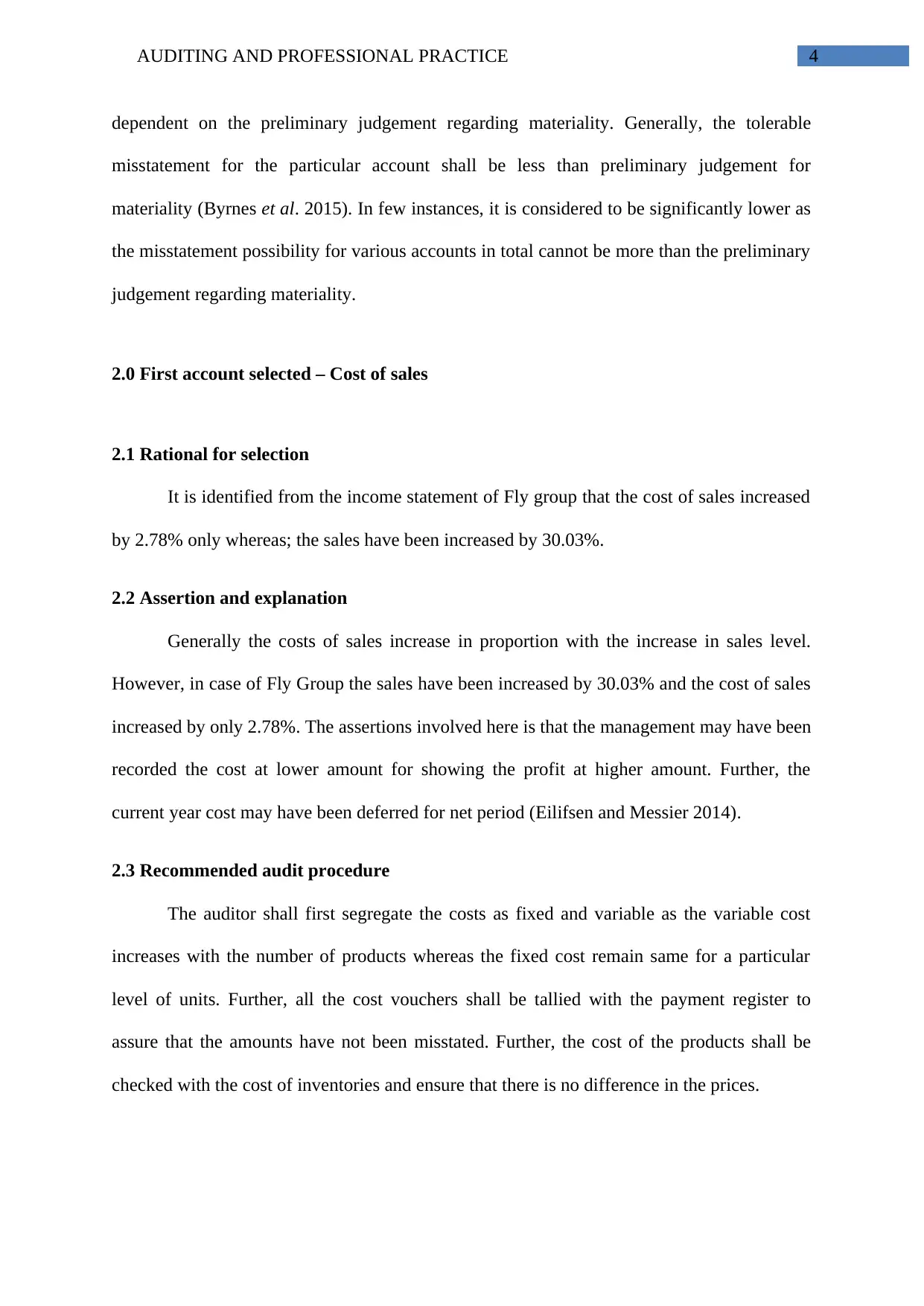
4AUDITING AND PROFESSIONAL PRACTICE
dependent on the preliminary judgement regarding materiality. Generally, the tolerable
misstatement for the particular account shall be less than preliminary judgement for
materiality (Byrnes et al. 2015). In few instances, it is considered to be significantly lower as
the misstatement possibility for various accounts in total cannot be more than the preliminary
judgement regarding materiality.
2.0 First account selected – Cost of sales
2.1 Rational for selection
It is identified from the income statement of Fly group that the cost of sales increased
by 2.78% only whereas; the sales have been increased by 30.03%.
2.2 Assertion and explanation
Generally the costs of sales increase in proportion with the increase in sales level.
However, in case of Fly Group the sales have been increased by 30.03% and the cost of sales
increased by only 2.78%. The assertions involved here is that the management may have been
recorded the cost at lower amount for showing the profit at higher amount. Further, the
current year cost may have been deferred for net period (Eilifsen and Messier 2014).
2.3 Recommended audit procedure
The auditor shall first segregate the costs as fixed and variable as the variable cost
increases with the number of products whereas the fixed cost remain same for a particular
level of units. Further, all the cost vouchers shall be tallied with the payment register to
assure that the amounts have not been misstated. Further, the cost of the products shall be
checked with the cost of inventories and ensure that there is no difference in the prices.
dependent on the preliminary judgement regarding materiality. Generally, the tolerable
misstatement for the particular account shall be less than preliminary judgement for
materiality (Byrnes et al. 2015). In few instances, it is considered to be significantly lower as
the misstatement possibility for various accounts in total cannot be more than the preliminary
judgement regarding materiality.
2.0 First account selected – Cost of sales
2.1 Rational for selection
It is identified from the income statement of Fly group that the cost of sales increased
by 2.78% only whereas; the sales have been increased by 30.03%.
2.2 Assertion and explanation
Generally the costs of sales increase in proportion with the increase in sales level.
However, in case of Fly Group the sales have been increased by 30.03% and the cost of sales
increased by only 2.78%. The assertions involved here is that the management may have been
recorded the cost at lower amount for showing the profit at higher amount. Further, the
current year cost may have been deferred for net period (Eilifsen and Messier 2014).
2.3 Recommended audit procedure
The auditor shall first segregate the costs as fixed and variable as the variable cost
increases with the number of products whereas the fixed cost remain same for a particular
level of units. Further, all the cost vouchers shall be tallied with the payment register to
assure that the amounts have not been misstated. Further, the cost of the products shall be
checked with the cost of inventories and ensure that there is no difference in the prices.
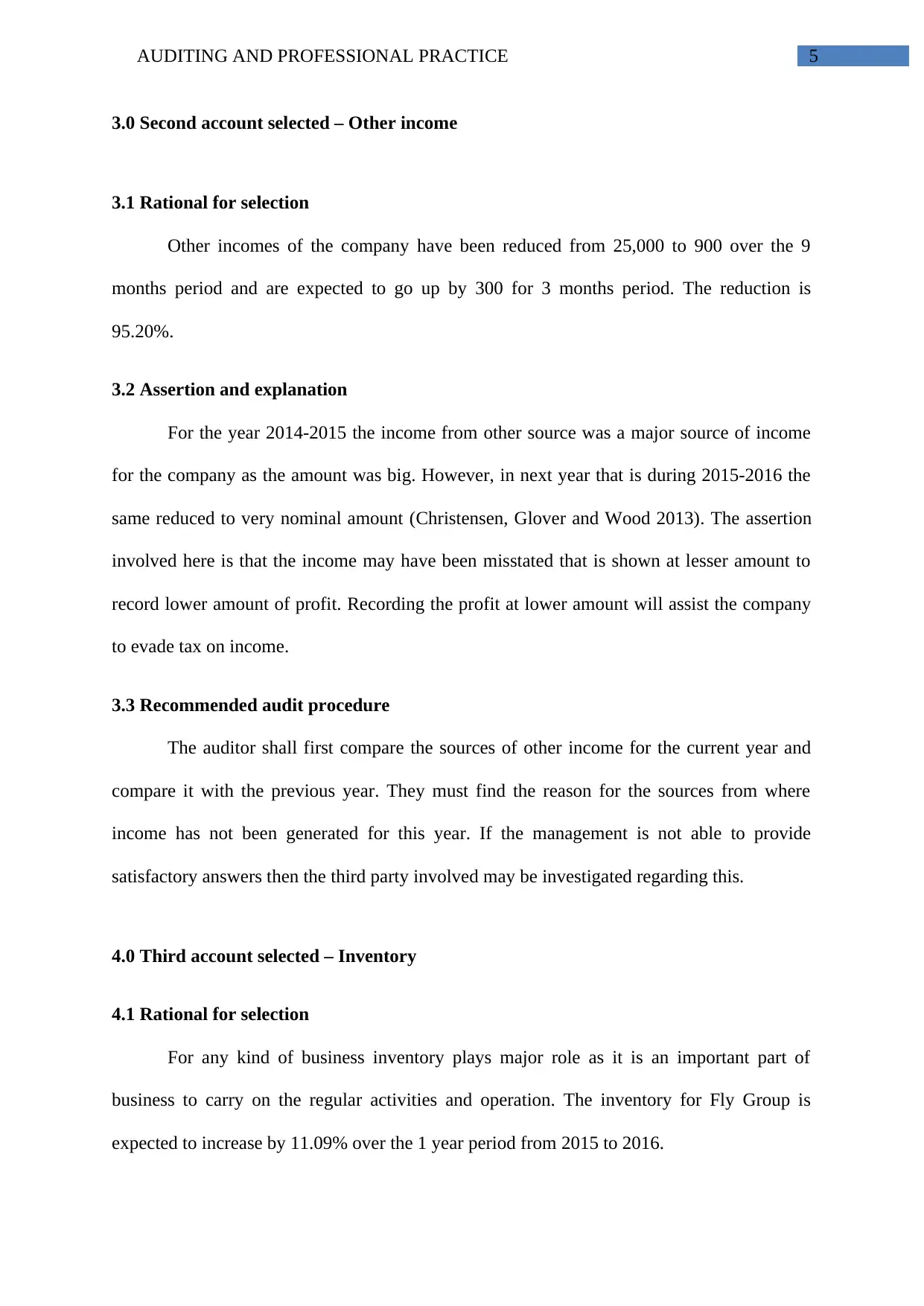
5AUDITING AND PROFESSIONAL PRACTICE
3.0 Second account selected – Other income
3.1 Rational for selection
Other incomes of the company have been reduced from 25,000 to 900 over the 9
months period and are expected to go up by 300 for 3 months period. The reduction is
95.20%.
3.2 Assertion and explanation
For the year 2014-2015 the income from other source was a major source of income
for the company as the amount was big. However, in next year that is during 2015-2016 the
same reduced to very nominal amount (Christensen, Glover and Wood 2013). The assertion
involved here is that the income may have been misstated that is shown at lesser amount to
record lower amount of profit. Recording the profit at lower amount will assist the company
to evade tax on income.
3.3 Recommended audit procedure
The auditor shall first compare the sources of other income for the current year and
compare it with the previous year. They must find the reason for the sources from where
income has not been generated for this year. If the management is not able to provide
satisfactory answers then the third party involved may be investigated regarding this.
4.0 Third account selected – Inventory
4.1 Rational for selection
For any kind of business inventory plays major role as it is an important part of
business to carry on the regular activities and operation. The inventory for Fly Group is
expected to increase by 11.09% over the 1 year period from 2015 to 2016.
3.0 Second account selected – Other income
3.1 Rational for selection
Other incomes of the company have been reduced from 25,000 to 900 over the 9
months period and are expected to go up by 300 for 3 months period. The reduction is
95.20%.
3.2 Assertion and explanation
For the year 2014-2015 the income from other source was a major source of income
for the company as the amount was big. However, in next year that is during 2015-2016 the
same reduced to very nominal amount (Christensen, Glover and Wood 2013). The assertion
involved here is that the income may have been misstated that is shown at lesser amount to
record lower amount of profit. Recording the profit at lower amount will assist the company
to evade tax on income.
3.3 Recommended audit procedure
The auditor shall first compare the sources of other income for the current year and
compare it with the previous year. They must find the reason for the sources from where
income has not been generated for this year. If the management is not able to provide
satisfactory answers then the third party involved may be investigated regarding this.
4.0 Third account selected – Inventory
4.1 Rational for selection
For any kind of business inventory plays major role as it is an important part of
business to carry on the regular activities and operation. The inventory for Fly Group is
expected to increase by 11.09% over the 1 year period from 2015 to 2016.
⊘ This is a preview!⊘
Do you want full access?
Subscribe today to unlock all pages.

Trusted by 1+ million students worldwide
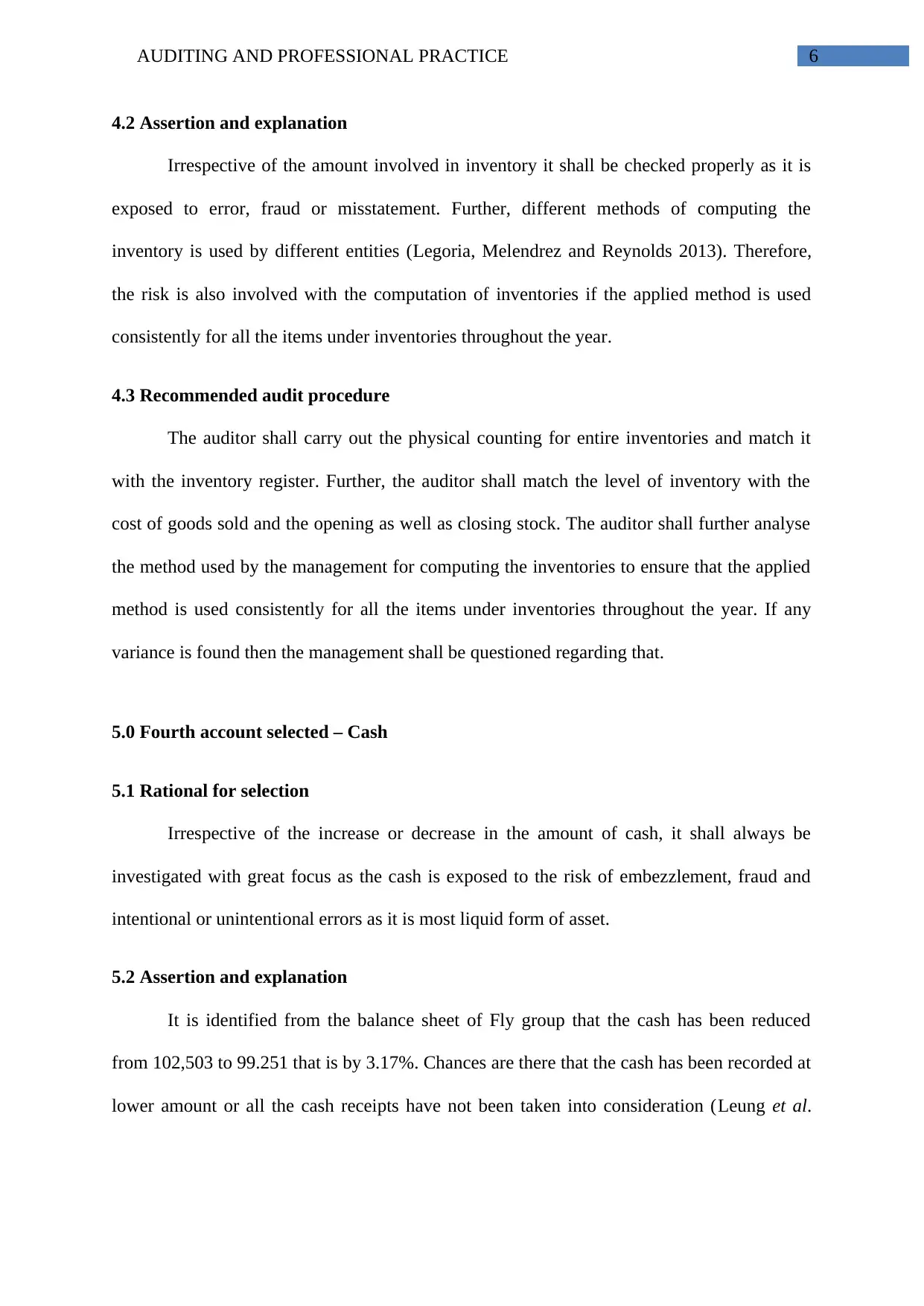
6AUDITING AND PROFESSIONAL PRACTICE
4.2 Assertion and explanation
Irrespective of the amount involved in inventory it shall be checked properly as it is
exposed to error, fraud or misstatement. Further, different methods of computing the
inventory is used by different entities (Legoria, Melendrez and Reynolds 2013). Therefore,
the risk is also involved with the computation of inventories if the applied method is used
consistently for all the items under inventories throughout the year.
4.3 Recommended audit procedure
The auditor shall carry out the physical counting for entire inventories and match it
with the inventory register. Further, the auditor shall match the level of inventory with the
cost of goods sold and the opening as well as closing stock. The auditor shall further analyse
the method used by the management for computing the inventories to ensure that the applied
method is used consistently for all the items under inventories throughout the year. If any
variance is found then the management shall be questioned regarding that.
5.0 Fourth account selected – Cash
5.1 Rational for selection
Irrespective of the increase or decrease in the amount of cash, it shall always be
investigated with great focus as the cash is exposed to the risk of embezzlement, fraud and
intentional or unintentional errors as it is most liquid form of asset.
5.2 Assertion and explanation
It is identified from the balance sheet of Fly group that the cash has been reduced
from 102,503 to 99.251 that is by 3.17%. Chances are there that the cash has been recorded at
lower amount or all the cash receipts have not been taken into consideration (Leung et al.
4.2 Assertion and explanation
Irrespective of the amount involved in inventory it shall be checked properly as it is
exposed to error, fraud or misstatement. Further, different methods of computing the
inventory is used by different entities (Legoria, Melendrez and Reynolds 2013). Therefore,
the risk is also involved with the computation of inventories if the applied method is used
consistently for all the items under inventories throughout the year.
4.3 Recommended audit procedure
The auditor shall carry out the physical counting for entire inventories and match it
with the inventory register. Further, the auditor shall match the level of inventory with the
cost of goods sold and the opening as well as closing stock. The auditor shall further analyse
the method used by the management for computing the inventories to ensure that the applied
method is used consistently for all the items under inventories throughout the year. If any
variance is found then the management shall be questioned regarding that.
5.0 Fourth account selected – Cash
5.1 Rational for selection
Irrespective of the increase or decrease in the amount of cash, it shall always be
investigated with great focus as the cash is exposed to the risk of embezzlement, fraud and
intentional or unintentional errors as it is most liquid form of asset.
5.2 Assertion and explanation
It is identified from the balance sheet of Fly group that the cash has been reduced
from 102,503 to 99.251 that is by 3.17%. Chances are there that the cash has been recorded at
lower amount or all the cash receipts have not been taken into consideration (Leung et al.
Paraphrase This Document
Need a fresh take? Get an instant paraphrase of this document with our AI Paraphraser
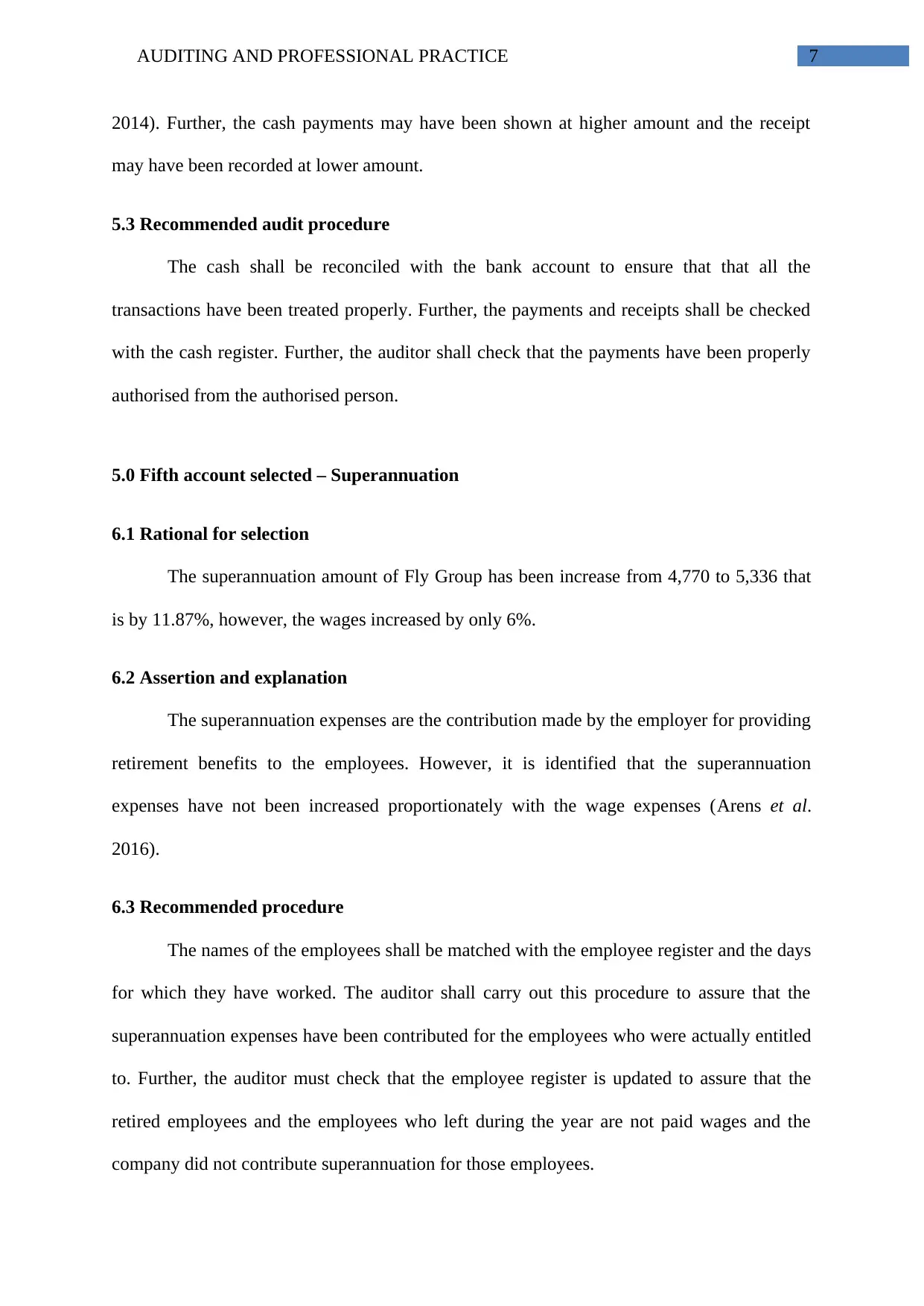
7AUDITING AND PROFESSIONAL PRACTICE
2014). Further, the cash payments may have been shown at higher amount and the receipt
may have been recorded at lower amount.
5.3 Recommended audit procedure
The cash shall be reconciled with the bank account to ensure that that all the
transactions have been treated properly. Further, the payments and receipts shall be checked
with the cash register. Further, the auditor shall check that the payments have been properly
authorised from the authorised person.
5.0 Fifth account selected – Superannuation
6.1 Rational for selection
The superannuation amount of Fly Group has been increase from 4,770 to 5,336 that
is by 11.87%, however, the wages increased by only 6%.
6.2 Assertion and explanation
The superannuation expenses are the contribution made by the employer for providing
retirement benefits to the employees. However, it is identified that the superannuation
expenses have not been increased proportionately with the wage expenses (Arens et al.
2016).
6.3 Recommended procedure
The names of the employees shall be matched with the employee register and the days
for which they have worked. The auditor shall carry out this procedure to assure that the
superannuation expenses have been contributed for the employees who were actually entitled
to. Further, the auditor must check that the employee register is updated to assure that the
retired employees and the employees who left during the year are not paid wages and the
company did not contribute superannuation for those employees.
2014). Further, the cash payments may have been shown at higher amount and the receipt
may have been recorded at lower amount.
5.3 Recommended audit procedure
The cash shall be reconciled with the bank account to ensure that that all the
transactions have been treated properly. Further, the payments and receipts shall be checked
with the cash register. Further, the auditor shall check that the payments have been properly
authorised from the authorised person.
5.0 Fifth account selected – Superannuation
6.1 Rational for selection
The superannuation amount of Fly Group has been increase from 4,770 to 5,336 that
is by 11.87%, however, the wages increased by only 6%.
6.2 Assertion and explanation
The superannuation expenses are the contribution made by the employer for providing
retirement benefits to the employees. However, it is identified that the superannuation
expenses have not been increased proportionately with the wage expenses (Arens et al.
2016).
6.3 Recommended procedure
The names of the employees shall be matched with the employee register and the days
for which they have worked. The auditor shall carry out this procedure to assure that the
superannuation expenses have been contributed for the employees who were actually entitled
to. Further, the auditor must check that the employee register is updated to assure that the
retired employees and the employees who left during the year are not paid wages and the
company did not contribute superannuation for those employees.
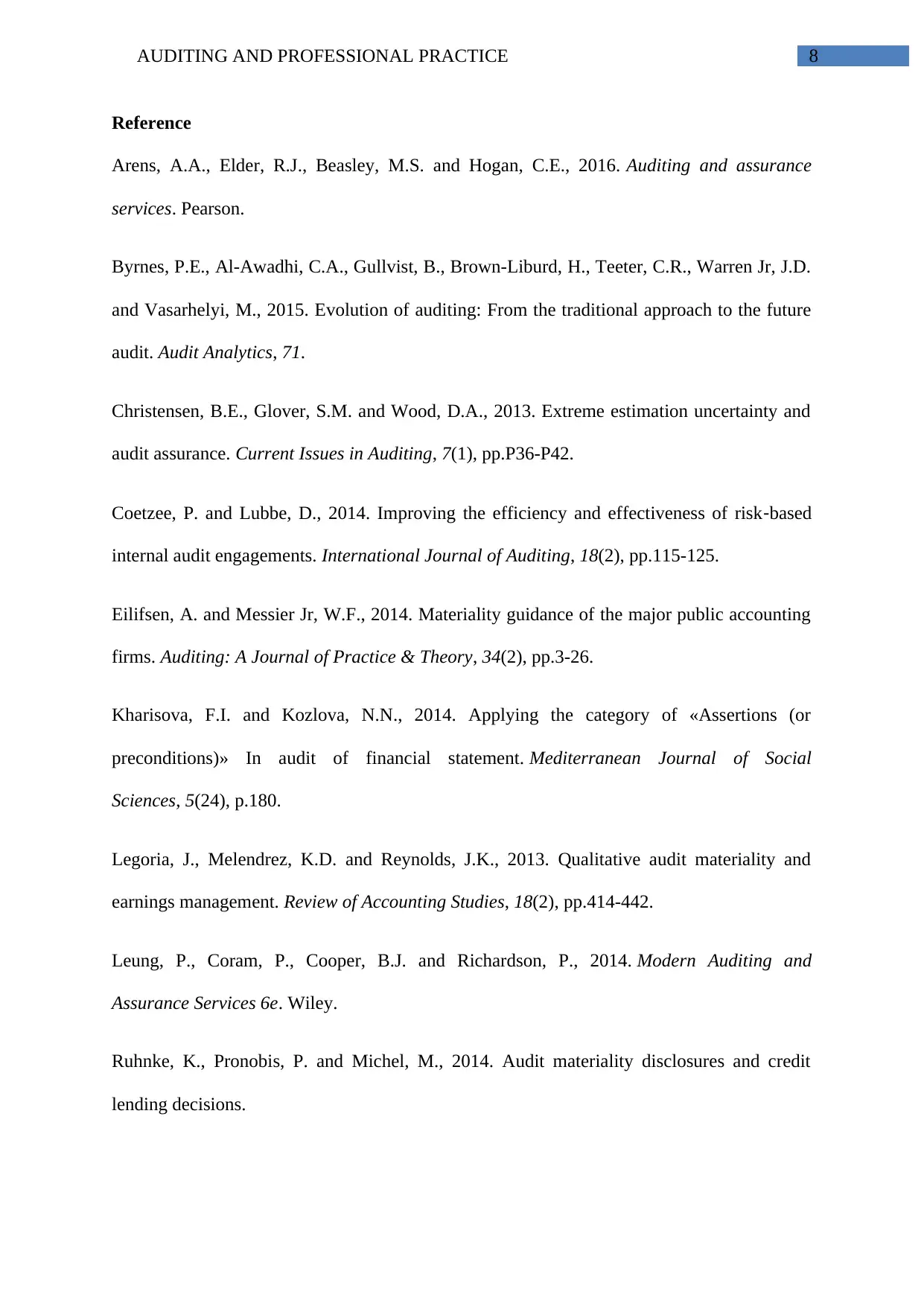
8AUDITING AND PROFESSIONAL PRACTICE
Reference
Arens, A.A., Elder, R.J., Beasley, M.S. and Hogan, C.E., 2016. Auditing and assurance
services. Pearson.
Byrnes, P.E., Al-Awadhi, C.A., Gullvist, B., Brown-Liburd, H., Teeter, C.R., Warren Jr, J.D.
and Vasarhelyi, M., 2015. Evolution of auditing: From the traditional approach to the future
audit. Audit Analytics, 71.
Christensen, B.E., Glover, S.M. and Wood, D.A., 2013. Extreme estimation uncertainty and
audit assurance. Current Issues in Auditing, 7(1), pp.P36-P42.
Coetzee, P. and Lubbe, D., 2014. Improving the efficiency and effectiveness of risk‐based
internal audit engagements. International Journal of Auditing, 18(2), pp.115-125.
Eilifsen, A. and Messier Jr, W.F., 2014. Materiality guidance of the major public accounting
firms. Auditing: A Journal of Practice & Theory, 34(2), pp.3-26.
Kharisova, F.I. and Kozlova, N.N., 2014. Applying the category of «Assertions (or
preconditions)» In audit of financial statement. Mediterranean Journal of Social
Sciences, 5(24), p.180.
Legoria, J., Melendrez, K.D. and Reynolds, J.K., 2013. Qualitative audit materiality and
earnings management. Review of Accounting Studies, 18(2), pp.414-442.
Leung, P., Coram, P., Cooper, B.J. and Richardson, P., 2014. Modern Auditing and
Assurance Services 6e. Wiley.
Ruhnke, K., Pronobis, P. and Michel, M., 2014. Audit materiality disclosures and credit
lending decisions.
Reference
Arens, A.A., Elder, R.J., Beasley, M.S. and Hogan, C.E., 2016. Auditing and assurance
services. Pearson.
Byrnes, P.E., Al-Awadhi, C.A., Gullvist, B., Brown-Liburd, H., Teeter, C.R., Warren Jr, J.D.
and Vasarhelyi, M., 2015. Evolution of auditing: From the traditional approach to the future
audit. Audit Analytics, 71.
Christensen, B.E., Glover, S.M. and Wood, D.A., 2013. Extreme estimation uncertainty and
audit assurance. Current Issues in Auditing, 7(1), pp.P36-P42.
Coetzee, P. and Lubbe, D., 2014. Improving the efficiency and effectiveness of risk‐based
internal audit engagements. International Journal of Auditing, 18(2), pp.115-125.
Eilifsen, A. and Messier Jr, W.F., 2014. Materiality guidance of the major public accounting
firms. Auditing: A Journal of Practice & Theory, 34(2), pp.3-26.
Kharisova, F.I. and Kozlova, N.N., 2014. Applying the category of «Assertions (or
preconditions)» In audit of financial statement. Mediterranean Journal of Social
Sciences, 5(24), p.180.
Legoria, J., Melendrez, K.D. and Reynolds, J.K., 2013. Qualitative audit materiality and
earnings management. Review of Accounting Studies, 18(2), pp.414-442.
Leung, P., Coram, P., Cooper, B.J. and Richardson, P., 2014. Modern Auditing and
Assurance Services 6e. Wiley.
Ruhnke, K., Pronobis, P. and Michel, M., 2014. Audit materiality disclosures and credit
lending decisions.
⊘ This is a preview!⊘
Do you want full access?
Subscribe today to unlock all pages.

Trusted by 1+ million students worldwide
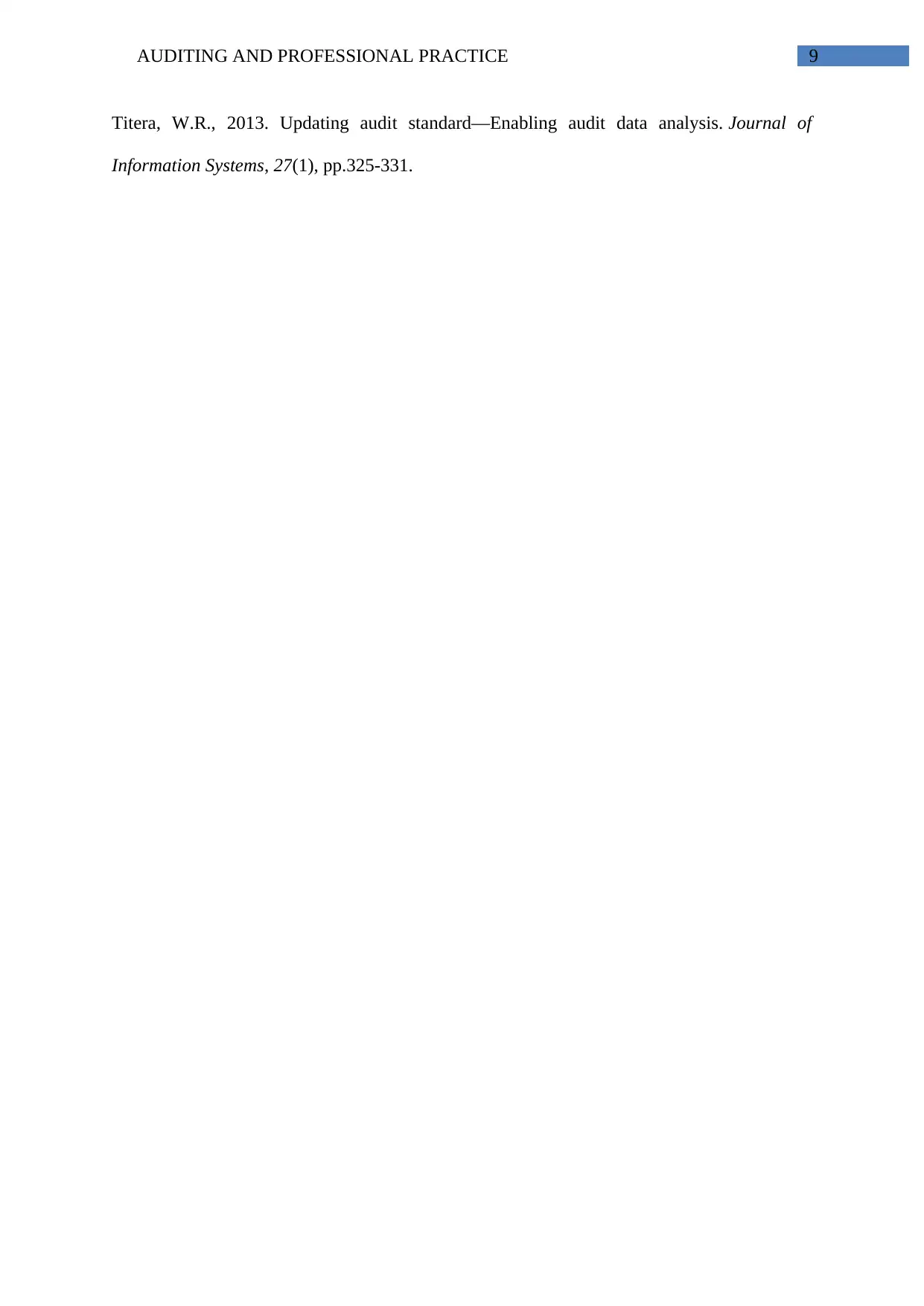
9AUDITING AND PROFESSIONAL PRACTICE
Titera, W.R., 2013. Updating audit standard—Enabling audit data analysis. Journal of
Information Systems, 27(1), pp.325-331.
Titera, W.R., 2013. Updating audit standard—Enabling audit data analysis. Journal of
Information Systems, 27(1), pp.325-331.
Paraphrase This Document
Need a fresh take? Get an instant paraphrase of this document with our AI Paraphraser
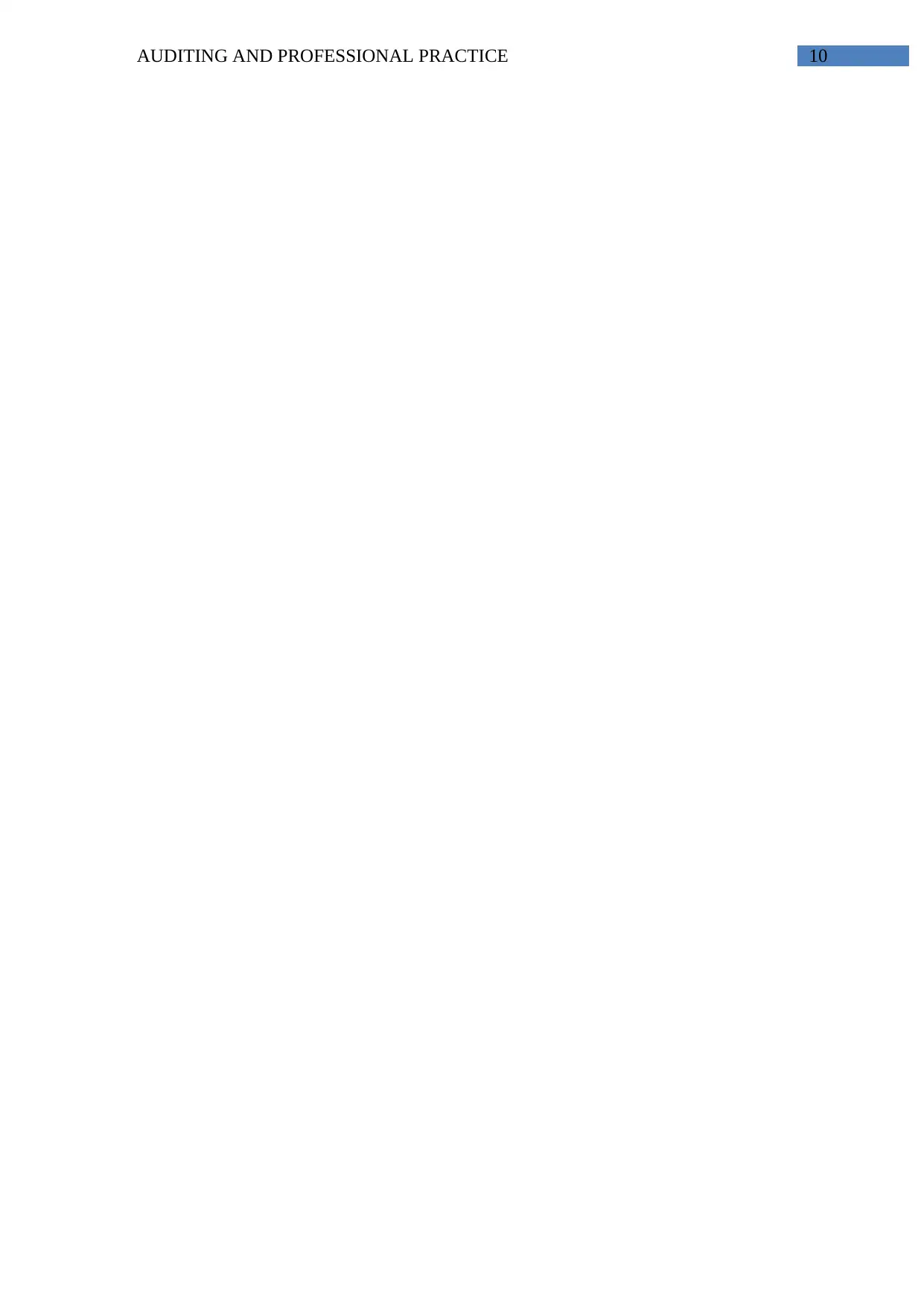
10AUDITING AND PROFESSIONAL PRACTICE
1 out of 11
Related Documents
Your All-in-One AI-Powered Toolkit for Academic Success.
+13062052269
info@desklib.com
Available 24*7 on WhatsApp / Email
![[object Object]](/_next/static/media/star-bottom.7253800d.svg)
Unlock your academic potential
Copyright © 2020–2025 A2Z Services. All Rights Reserved. Developed and managed by ZUCOL.


